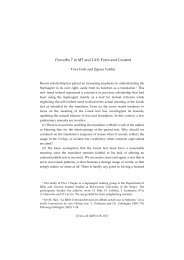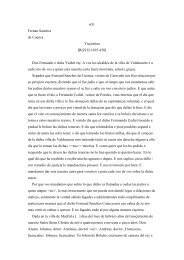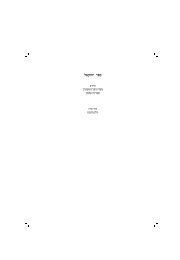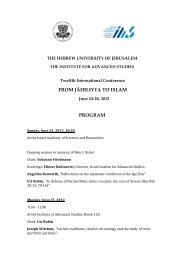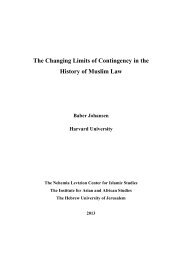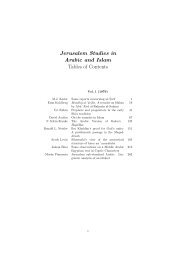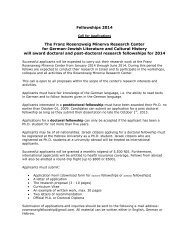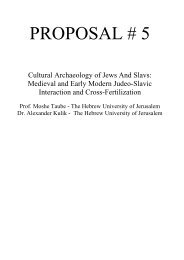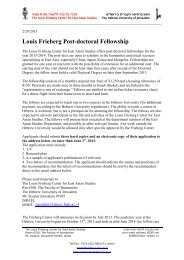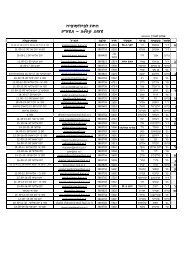THE BOOK OF EZEKIEL Moshe H. Goshen-Gottstein Shemaryahu ...
THE BOOK OF EZEKIEL Moshe H. Goshen-Gottstein Shemaryahu ...
THE BOOK OF EZEKIEL Moshe H. Goshen-Gottstein Shemaryahu ...
You also want an ePaper? Increase the reach of your titles
YUMPU automatically turns print PDFs into web optimized ePapers that Google loves.
I. The History of the Text of Ezekiel as Reflected in the Apparatuses<br />
9. These considerations account for the basic difference between the structure of Apparatus<br />
I and that of the other apparatuses. Whereas Apparatus I pertains to the earliest stage<br />
in the written transmission of the biblical text and evidences a degree of textual pluriformity,<br />
the other apparatuses (with the exception of readings from Qumran and Masada<br />
fragments in Apparatus II) reflect a later stage. Efforts were made to include in Apparatus<br />
I every suggestion worthy of consideration. Suggested explanations for the data recorded<br />
are presented in the notes.<br />
10. Another aspect of the examination of the textual data in toto affects the division of the<br />
material into several apparatuses. Were knowledge of the facts more firmly founded, it<br />
might have been possible to present the evidence in an even stricter historical manner, for<br />
example, by subdividing the data into an apparatus of witnesses from the period before the<br />
destruction of the Second Temple, and one of the early post-destruction witnesses. From<br />
that time on, the history of the biblical text differs fundamentally from its history of transmission<br />
in previous periods. The destruction of the Temple and the following period, that<br />
is, the last third of the first and the first third of the second century CE, is the main dividing<br />
line in the history of the textual transmission of the Bible as far as it can be recovered. 7<br />
11. After this stage the ‘(proto-) masoretic’ text tradition gained complete dominance, to<br />
all intent and purpose, although it did not yet achieve uniformity. Without entering into a<br />
discussion of the complex problem of the evolution of the versional traditions, a subdivision<br />
of each apparatus along the said dividing line in the transmission history of the biblical text<br />
would create more problems than it would solve. For theoretical and practical considerations<br />
it is preferable to assemble retroverted readings from the versions in the first apparatus,<br />
and to record in the second apparatus the Hebrew materials collated from Bible manuscripts<br />
that are not of the ‘masoretic’ period (see below, chapter 5).<br />
12. As mentioned above, the transmission history of the text of the Hebrew Bible is particularly<br />
complex, as evinced by the variety of different types of sources in various languages.<br />
Therefore, the questions of method confronting editors of biblical books are rather<br />
different from those confronting an editor engaged in the collating of textual data from<br />
manuscripts in one language. The indiscriminate recording of every apparent textual divergence<br />
in a translation or in a biblical quotation in a Midrash manuscript would needlessly<br />
clutter a critical apparatus. Such variant readings must be carefully weighed and evaluated<br />
before deciding which to enter in the apparatus.<br />
13. Apparatus III contains readings resulting from processes of scribal transmission (such<br />
as harmonization, inversion, conflation, etc.) and linguistic variants. In contrast, apparatuses<br />
I and II also contain variants of other types, such as readings deriving from possibly<br />
divergent textual traditions and synonymous readings. This basic difference puts the Bible<br />
manuscripts from the ninth century CE onward in a category of their own. 8<br />
International Organization for Septuagint and Cognate Studies (ed. C. Cox; Septuagint and Cognate<br />
Studies 23; Atlanta: Scholars Press, 1987) 405–424. For the importance of the evaluation of<br />
translation technique in the text-critical use of the Septuagint in general cf. Tov, TCU, 17–29.<br />
7 Cf. Talmon, “Textual Criticism,” 147–148.<br />
8 See M. H. <strong>Goshen</strong>-<strong>Gottstein</strong>, “Hebrew Biblical Manuscripts: Their History and Their Place in the<br />
HUBP Edition,” Biblica 48 (1967) 243–290. Cf. also Tov, TCHB, 37–39.<br />
xiii



